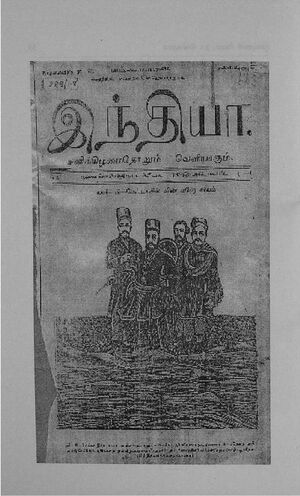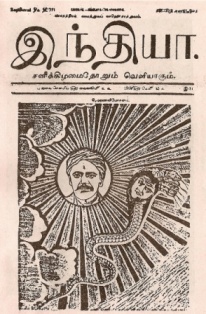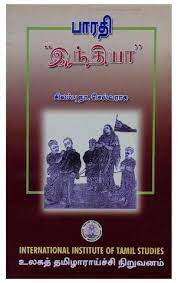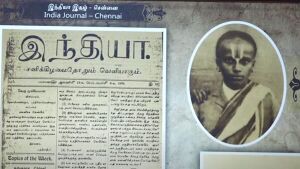India (Magazine)
இந்தப் பக்கத்தை தமிழில் வாசிக்க: இந்தியா (இதழ்)
India was a weekly magazine started during 1906. The Magazine, which was initially published in Chennai, was shifted to Pondicherry due to a ban by the English Government. At Pondicherry, India (Magazine) was published between 1908 to 1910.
Launched on May 9, 1906 in Chennai, Bharathiyar became the editor of the magazine during September 1906. Mandayam Thirumalachariyar was the owner of the magazine. When Bharathi was the Editor-in-Chief of India Magazine, M. Srinivasa Iyengar’s name was printed. India Magazine is known as the magazine that published Bharathi's writings.
Magazine Launch
India Magazine, which gained popularity as C. Subramaniya Bharathiyar was the Editor, was launched on May 9, 1906 in Chennai and was published on a weekly basis on Saturdays (The first issue was launched on Wednesday and later was published on Saturdays on a weekly basis). Thirumalachariyar, who used to write for Pirathivathi - a Vedanta Magazine run by Azhagiya Singer in Chennai, started the India Magazine. M.S. Subramaniya Iyer, who had worked alongside Bharathiyar as assistant editor in Swadesamitran and authored Biographies of many National leaders, mentioned in his book 'Subramaniya Bharathiyar’ that Thirumalachariyar had started the magazine for the sake of Bharathiyar.
Thirumalachariyar, the owner of the magazine, also served as the editor. Mandayam Chakravarthy also known as Azhagiya Singa Perumal and M.P.T. Achariya, who was actively involved in the Indian Independence movement, assisted Thirumalacharya in the early days of the magazine. M. Srinivasa Iyengar (Murappakkam Srinivasan), a schoolmate of Thirumalachariyar, who was working in the Railway Auditor office took charge as the editor. In September 1906 Bharathiyar came to work for India magazine.
Many changes took place in the print when Bharathi took charge of the magazine. A distinct style was developed in writing its title page. This can be seen in the praises of later Indian magazines such as Amirthaguna Bodhini (November 1928), Vivekabanu, Rangoon Swadesha Paripalini, Hindu Sadanam and Swadesamithiran.
Shift to Pondicherry
Thoughts on Indian independence and anti-British propaganda were published in India magazine. The government issued a warrant for Mandayam Thirumalachari, the owner of India Magazine, and M. Srinivasa Iyengar, who was registered as the editor. Due to government action, India Magazine stopped publishing in Chennai from the last week of September 1908.
Bharathiyar and the magazine owner Thirumalachari fled to Pondicherry. As the printing press could be set up in Pondicherry only if a person born in French India granted bail, Villianur S. Lakshmi Narayana Iyer, a friend of Thirumalachariyar, volunteered and granted them bail. The printing press was located in Building No. 71, Ambalatharu Street. The first India Magazine (Pondicherry) was released on October 20, 1908.
The India Magazine launched in Pondicherry had the caption Swathandiramum, Samasthuvamum, Sagotharathuvamum (Liberty, Equality, Fraternity) in the title page. The government banned the magazine published in Pondicherry from entering British India.
The India magazine (Pondicherry) ceased publication on March 12, 1910 due to various economic and political crises.
Case
Twenty articles published by India Magazine in Chennai from February 29, 1908 to June 27, 1908 were compiled as crimes against the government. Out of which, the magazine editors were prosecuted for publishing three articles, 'Mahabharatha Kadhaigal (Mahabharata Stories), Ethanaiyo Kollaigalil Idhuvum Oru Kollai’ (A Robbery out of the many Robberies), En Kaalathai Veenaaka Vendum (Why to Waste Time). The office of the 'India' Magazine was raided on August 21, 1908 and the next day. Bharathiyar fled to Pondicherry. When the case ended M. Srinivasa Iyengar, who was registered as the editor, was sentenced to five years in prison.
Content
Magazine Title Details
The Caption 'Swathandiramum, Samasthuvamum, Sagotharathuvamum’ (Liberty, Equality, Fraternity) was mentioned below the title of the magazine. This was the slogan of the French Revolution. The register number was mentioned in the left and right of the caption and 'Sanikizhamai Dhorum Veliyagum (Will be released every Saturday) was mentioned at the bottom.
Image (Concept Art)
Cartoons
Apart from the news, articles and editorial, a political cartoon was also published in the first page of the India Magazine. 'India' was the first magazine to use cartoons for political propaganda. A cartoon and an explanation of the cartoon was depicted below the title of the magazine. A.R. Venkatachalapathi compiled all the cartoons published in the India Magazine and released a book named Bharathiyin Karuthupadangal (Bharathi’s Concept Art).
Cartoon Explanation
An explanation of the cartoon (the political background of the cartoon) was given in the first paragraph of the second page in the magazine.
News Snippets
The News Snippets were featured in the section between the cartoon explanation and the editorial. This section had small news snippets. (Example: Thoothukudi Sudesi Shipping Company; A donation to the Thoothukudi Swadeshi Steam Navigation Company)
Editorial
The Editorial starts on the third page of the India Magazine. The editorial will be featured below the title "India Soumya Purattasi 31U".
Poems
India Magazine features two types of poems:
- Greeting Poem (Set in Asiriyappa)
- Libel Poems (Set in Kummi Song Form)
Bharathi’s famous greeting poem 'Vaazhiya Senthamizh was published in India Magazine. It was written under the title Pudhu Varusham (New Year) to mark the second anniversary of India Magazine.
The poem written to mock the appointment of V. Krishnaswamy Iyer as the judge in the Chennai High Court, can be said as an example of Libel poem.
Conversation
In India Magazine, few news articles were published by using the conversation strategy. The British and Frenchsegment below is an example of such news segments.
Articles
Since India Magazine was a magazine that gave importance to news related to politics, political articles were published in many releases. (Eg: Articles such as Prison History, Excerpt of Sri Aurobindo Ghosh prison experience, Real Kings)
Letter (Epistle)
The letter segment had political articles in the format of a letter. (Eg: A series of letters were published entitled 'Hindu’s Bravery - An Epistle’
Bharathi and India Magazine
India is a political newspaper published in Tamil. It was a magazine that wrote critical reviews of the events of that period. Those critical reviews were also written from a certain political perspective. The aim of 'India' magazine was to gain independence from British domination. So the articles released were in the nature of criticizing the government.
Specifically, Bharathiyar, who was its editor, used India Magazine as a medium to express his political views.
Some of the critical article written by Bharathi in India Magazine:
- Condemning the incident where a policeman prevented a Swadeshi gathering in May 1907, Bharthi wrote in India Magazine as follows, "People! You are the owners of this land. You pay the ruler’s salary and they are at your service. If a ruler does not work properly you have the power to change it. Recognize your freedoms and rights and unabashedly suppress those who interfere with your activities that are legal. The mischievousness of the police doesn’t work for those who are courageous. Even the devil doesn’t trouble the courageous people (India,4.5.1907, Bharathi Dharisanam II)."
- In the same month, Bharathi wrote condemning the action of the Collector who had blocked the Shivaji procession in Thanjavur.
- Upon hearing the news of Lala Lajpat Rai's deportation in 1907, Bharati wrote in India under the headline 'Arajagam' (Tyranny) and Aarya Jaadhiku Nadandha Avamaanam (Insult to the Aryan Caste).
Documentation
The damaged version of India's first issue, published on May 7, 1906, was found during later days. It was published by Bharathi in the second edition of the 'Darisanam'.
Of the magazines published from Chennai and Pondicherry, 125 were available and more than 60 were not available. With Respect to this researcher A.R. Venkatachalapathi states that(1994),
The first six issues of India Magazine are not yet available. Only the top half of the first issue published was discovered by C.S. Subramaniam. Magazines from June 23, 1906 to June 22, 1907 are consolidated in a single volume and maintained in the Calcutta National Library. But it does not include the three issues released in November.
Only five of the magazines published from June 29, 1907 to September 5, 1908 were found. These are in the Pondicherry Mahakavi Bharathiyar Memorial Museum and Research Centre. Magazines published in Pondicherry since October 10, 1908 were re-organized and released named as Book 1 Issue No. 1. From this till Book 1 Issue No. 52 (published on October 9, 1909) was found. Book 2 Issue No 2 to 20 published from 20 October 16, 1909 were received from R.A. Padmanaban and maintained in the Puducherry Museum.
The British and the French
When the Governor banned India Magazine from operating in Chennai, the magazine started operations again in Pondicherry. Due to this, the Governor of Chennai wrote to the Governor of Pondicherry in November and December 1908 to ban the magazine. The French governor wrote in his letter that India's magazine had not violated their country's printing rights and hence could not be barred.
This incident was featured in the January 2, 1909 issue of India Magazine as a picture and an article title Oar Sambashanai (A Conversation).
End of India Magazine-Discussions
There are various opinions about the period when India magazine was discontinued. Although the magazine was known to have stopped on March 12, 1910, P. Iraiyarasan (1995) states that it was secretly published until September 1910. Since the last issue found so far of 'India’ Magazine was dated March 12, 1910, P. Thuran, R.A. Padmanaban, Premananda Kumar, S. Ramakrishnan considers it as the last day of the magazine publication. But secret documents of the British government indicate that one or two magazines have been published post March 12, 1910. S. Lakshmi Narayana Iyer wrote letters to the Governor of Chennai three times during March and April 1910, to grant bail for Pondicherry 'India’ Magazine. At the end of April, a letter was sent from the Governor of Chennai saying that the ban could not be changed.
After that letter, Lakshmi Narayana Iyer wrote a long letter asking which sections of the magazine were against the government. Due to lack of response the magazine was stopped at the end of April as stated in the secret document of the British government dated May 17, 1910.
Against the British Government articles such as:
- Sivaji Patriya Kuripugal (Notes on Sivaji)
- Veeram (Valour)
- Arubathu Kodi Rubaiku India Kollai Idapadugiradam (India is being looted for Sixty crore rupees)
- Adhika Arasinarin Neediyatra Manidha Thanmaiyatra Sattangal (Unjust and Inhumane Laws of the Dominant Government)
- Edhu Unmai (Which is True)
- Translation from Don Magazine
- Translation from Karmayogi's Magazine
- Translation from Dharma Magazine
- British Indiavin Nilamai (The situation in British India)
were published on July 2 and 23, 1910, as mentioned in the statement by the British government. P. Iraiyarasan quotes Ko. Kesavan’s statement that the British Government of India had issued orders to the Judiciary and the Post Office departments in August and September using the Magazine Act and thus concludes that the Magazine was published until September.
Historical Significance
'India’ Magazine was an important reason for the Independence movement to gain traction in South India. Researchers consider 'India’ Magazine to be the first South Indian magazine to intensify quest for independence and opposition to the British government.
References
- Bharathi India: Book on Bharathi’s Pondicherry India Magazine, Silambu N. Selvarasu, 2003, World Tamil Research Centre, Pondichery
- Bharathiyar: Magazine Innovator, Journalism departments Pioneer, Tamil Hindu, September 11, 2021
- Bharathiyar Memorial Day: How was Bharathi’s life in poverty?, ilakkiyainfo.com, September 12, 2020
- Rare photos of Bharathiyar, mahakavibharathiyar.info
- Bharathi Academy, India Magazine, M.S. Subramaniya Iyer Notes
✅Finalised Page
First published on:
03-Oct-2022, 13:55:56 IST




